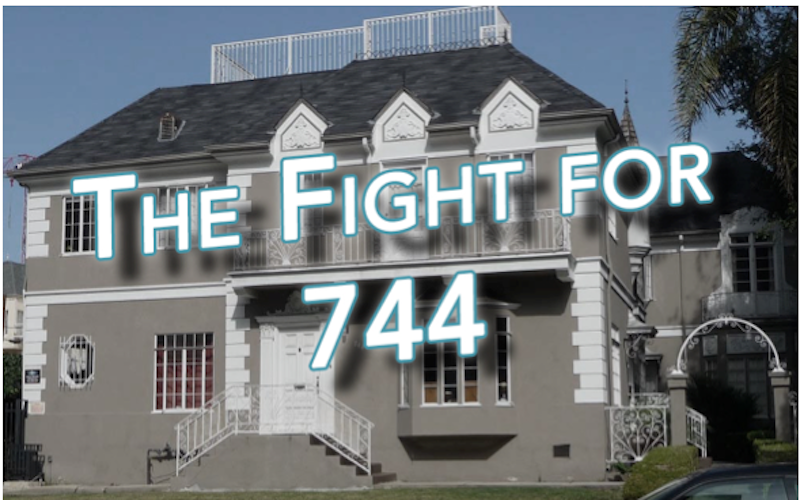CommentsDENSITY DEBACLE-Over the last three years, the residents of the Miracle Mile have been fighting to obtain an Historic Preservation Overlay Zone (HPOZ) to preserve the charm and scale of their historic neighborhood. The Miracle Mile emerged in the 1920s and 1930s as the nation’s first linear downtown – a commercial shopping district stretched along Wilshire Boulevard between La Brea and Fairfax – bounded by block after block of multi-family apartment buildings and single family homes.
The historical continuity of the Miracle Mile was one of the key reasons why, in Autumn 2016, the Miracle Mile HPOZ was approved by the city’s Cultural Heritage Commission.
Then on December 8, 2016 the City Planning Commission weighed in. The Commission endorsed the HPOZ with one hand and gutted it with the other, cutting out historic properties along Olympic Boulevard, on South Orange Grove Avenue, and between 8th Street and Wilshire Boulevard (see map below.) Suddenly, 79 historic buildings and 500 rent-stabilized apartments were placed in jeopardy – and big-box development was given a green light.
It is neither a coincidence nor a surprise that soon after the Commission excluded these properties from the pending Miracle Mile HPOZ, an application to demolish 744 South Ridgeley Drive was submitted to the city. Nor that, on February 20, 2017, the tenants received eviction notices. 744 South Ridgeley has the misfortune of sitting right where the Commission drew its pro-development boundaries.
Yet, 744 S. Ridgeley epitomizes the historic character of the Miracle Mile. The six-unit apartment building was built in 1937 – during one of the city’s biggest growth spurs in which “period revival” was the rage. The apartment house was designed to resemble a French Chateau by Edith Northman (photo below,) the only licensed female architect in Los Angeles at the time. Northman designed five other residences in the Miracle Mile: 1044 S. Cloverdale Avenue (1927), 1024 S. Dunsmuir Avenue (1929), 749 S. Burnside Avenue (1931), 1031 S. Burnside Avenue (1932), 1000 S. Dunsmuir Avenue (1942) -- all of which were deemed “full contributors” to the Miracle Mile HPOZ. Now, three of Northman’s Miracle Mile buildings have been put on the chopping block by the City Planning Commission – 744 quite literally.
With its turret and dormers and finials and steel casement windows – and elegant courtyard – 744 S. Ridgeley Drive is an apt example of what makes the Miracle Mile so livable, desirable, and culturally significant. Step inside the apartments and this judgment is only further confirmed: light, spacious, airy rooms detailed with finely crafted moldings, hardwood floors, and bronze hardware. (Photo left: Architect Edith Northman)
What’s more, like most of the multi-family buildings in the neighborhood, 744 S. Ridgeley is rent-controlled. Long-time tenants have been able to put down roots in the neighborhood because their homes remain affordable, by law. Should this building fall to the bulldozers, six more rent stabilized (RSO) apartments will disappear forever. And, as irreplaceable as the architecture is, these apartments themselves are even more irreplaceable amidst the city’s severe, and deepening, affordability crisis (nearly sixty percent of renters pay more than 30% of their monthly income in rent.) Of course, the Miracle Mile HPOZ would have preserved the building, while protecting its rent stabilized units – and occupants.
But the city Planning Commission decision to exclude Ridgeley north of 8th Street, along with the other redlined streets, means this historic apartment building faces imminent destruction. Why? Planning Commission chair David Ambroz – who in an appointee of Mayor Eric Garcetti – argued that the Wilshire corridor needs increased residential density. That was his justification for ignoring the recommendations of his own Cultural Commission and Planning staff. Yet, not only has the boulevard experienced unabated densification in the last decade, there is still room to grow up without tearing down the small-scale, historic buildings that are the essential fabric of the Miracle Mile.
Wilshire Boulevard has no height limits; Wilshire Boulevard has many undistinguished buildings; Wilshire Boulevard has three enormous parcels between Fairfax and La Brea, which the subway builders will convert to mega-structures when tunneling is completed. There is, in other words, ample space to accommodate new residents – without sacrificing a single rent stabilized or historic structure.
The Miracle Mile Residential Association has made a short video to introduce the real people whose lives are about to be upended by the demolition of 744 South Ridgeley. Ultimately, it is the residents who are being asked to sacrifice their homes to David Ambroz’s and Eric Garcetti’s vision. It is time we let their voices be heard.
Over 1000 people have signed a petition or sent messages demanding that City Hall reinstate historic properties, like this one on Ridgeley, into the Miracle Mile HPOZ. To add your support click on: Support.MiracleMileLA.com
(Greg Goldin is the coauthor of Never Built Los Angeles and a curator at the A+D Museum. From 1999 to 2012, he was the architecture critic at Los Angeles Magazine. He is a longtime resident of the Miracle Mile and was featured in the MMRA Channel's YouTube presentation: "The Miracle Mile in Three Tenses: Past, Present, and Future." This piece was posted first in the excellent Miracle Mile Residential Association Newsletter.) Prepped for CityWatch by Linda Abrams.
Sidebar

 CityWatch Los Angeles
Politics. Perspective. Participation.
CityWatch Los Angeles
Politics. Perspective. Participation.
24
Wed, Apr










